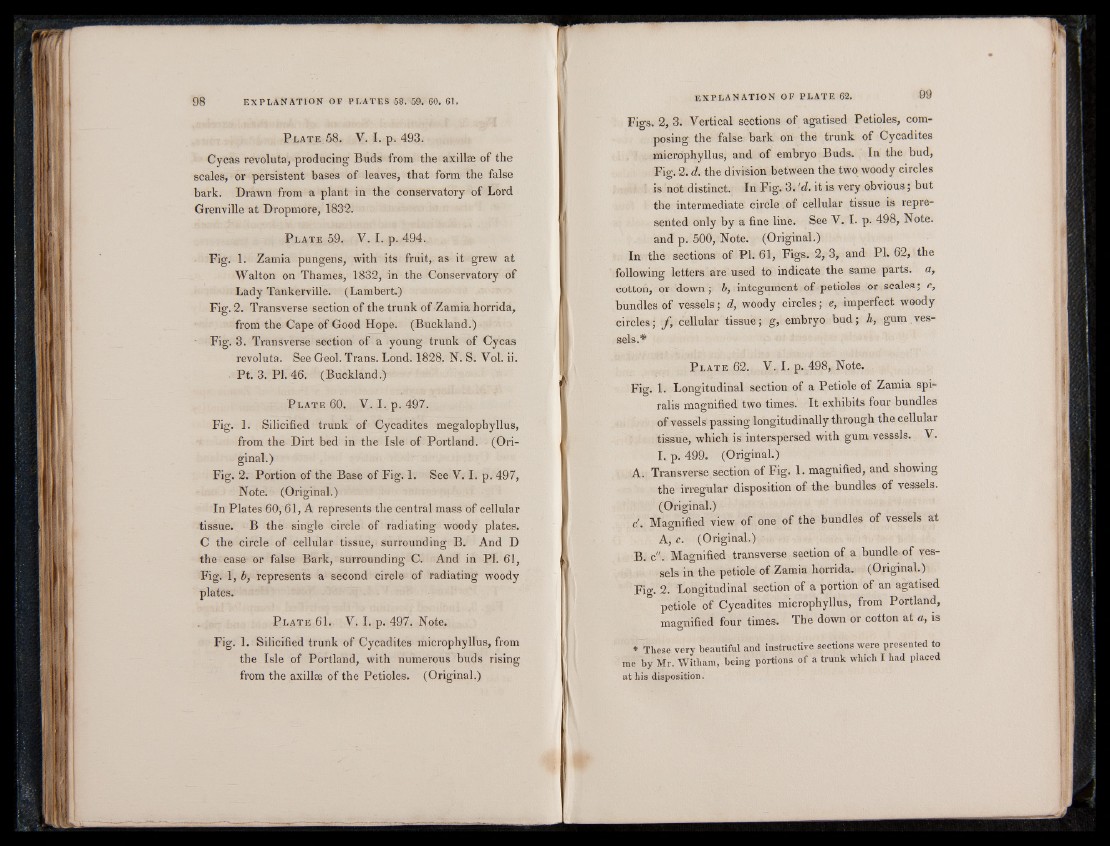
P l a t e 58. V. I. p. 493.
Cycas revoluta, producing Buds from the axillae of the
scales, or persistent bases of leaves, that form the false
bark. Drawn from a plant in the conservatory of Lord
Grenville at Dropmore, 1832.
P l a t e 59. V. I . p. 494.
Fig. 1. Zamia pungens, with its fruit, as it grew at
Walton on Thames, 1832, in the Conservatory of
Lady Tankerville. (Lambert.)
Fig. 2. Transverse section of the trunk of Zamia horrida,
from the Cape of Good Hope. (Buckland.)
Fig. 3. Transverse section of a young trunk of Cycas
revoluta. See Geol. Trans. Lond. 1828. IN’. S. Yol. ii.
Pt. 3. PI. 46. (Buckland.)
P l a t e 60. V. I. p. 497.
Fig. 1. Silicified trunk of Cycadites megalophyllus,
from the Dirt bed in the Isle of Portland. (Original.)
Fig. 2. Portion of the Base of Fig. 1. See V. I. p. 497,
Note. (Original.)
In Plates 60,61, A represents the central mass of cellular
tissue. B the single circle of radiating woody plates.
C the circle of cellular tissue, surrounding B. And D
the case or false Bark, surrounding C. And in PI. 61,
Fig. 1, b, represents a second circle of radiating woody
plates.
P l a t e 61. V. I. p. 497. Note.
Fig. 1. Silicified trunk of Cycadites microphyllus, from
the Isle of Portland, with numerous buds rising
from the axillae of the Petioles. (Original.)
Figs. 2, 3. Vertical sections of agatised Petioles, composing
the false bark on the trunk of Cycadites
microphyllus, and of embryo Buds. In the bud,
Fig. 2. d. the division between the two woody circles
is not distinct. In Fig. 3. 'd. it is very obvious; but
the intermediate circle of cellular tissue is represented
only by a fine line. See V. I. p. 498, Note,
and p. 500, Note. (Original.)
In the sections of PI. 61, Figs. 2, 3, and PI. 62, the
following letters are used to indicate the same parts, a,
cotton, or down; b, integument of petioles or scales; c,
bundles of vessels; d, woody circles; e, imperfect woody
circles; ƒ, cellular tissue; g, embryo bud; h, gum.vessels.*
P l a t e 62. V. I. p. 498, Note.
Fig. 1. Longitudinal section of a Petiole of Zamia spiralis
magnified two times. It exhibits four bundles
of vessels passing longitudinally through the cellular
tissue, which is interspersed with gum vesssls. V.
I. p. 499. (Original.)
A. Transverse section of Fig. 1. magnified, and showing
the irregular disposition of the bundles of vessels.
(Original.)
c\ Magnified view of one of the bundles of vessels at
A, c. (Original.)
B. c". Magnified transverse section of a bundle of vessels
in the petiole of Zamia horrida. (Original.)
Fig. 2. Longitudinal section of a portion of an agatised
petiole of Cycadites microphyllus, from Portland,
magnified four times. The down or cotton at a, is
* These very beautiful and instructive sections were presented to
me by Mr. Witham, being portions of a trunk which I had placed
at his disposition.